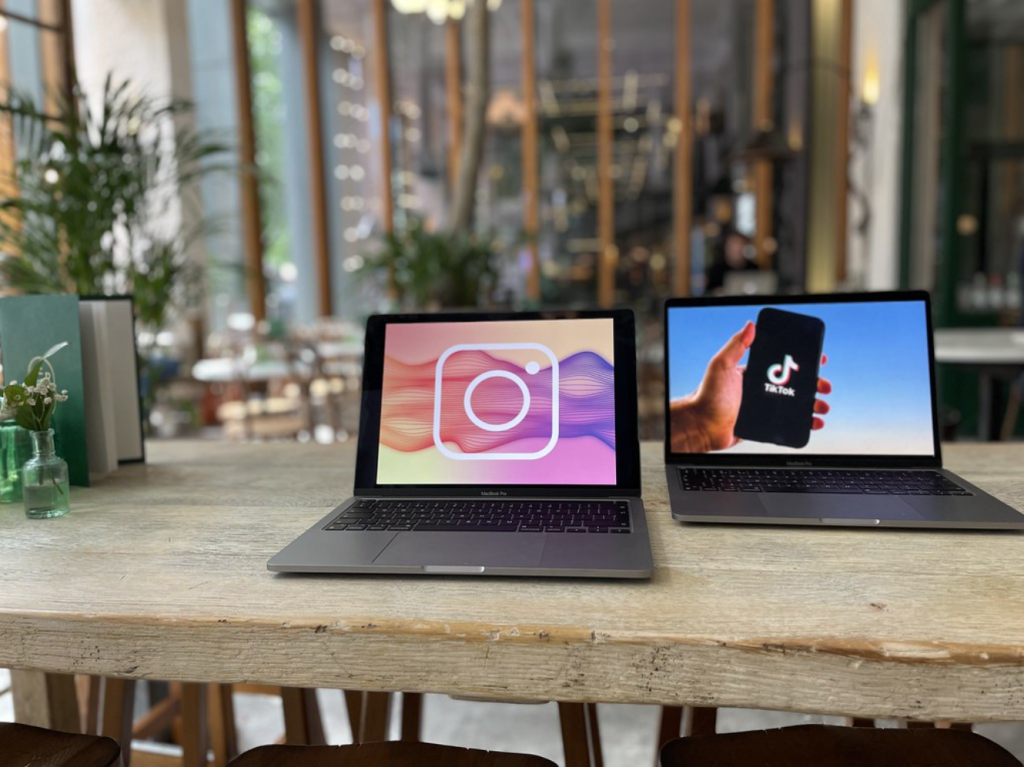
Instagram from Meta, as a social media platform, provides users the opportunity to capture, edit and share photos, videos and messages.
Instagram from Meta, as a social media platform, provides users the opportunity to capture, edit and share photos, videos and messages. In today’s digital era, appearance-focused social networking sites including Facebook and Instagram have reshaped how individuals connect and interact, with a significant focus on capturing life moments through visuals (Cohen, R & Slater, A.2017). Yet, this vast collection of visuals has inadvertently fostered specific stereotypes. The most notable among these is the portrayal of body image, predominantly affecting many young women. This piece will explore the amplification of such body image stereotypes by the social media platform Instagram and underscore the significance of recognizing the bias and stereotypes on the social media platforms to resist monotonic beauty standards on the site.
The rising body image concerns on Instagram
In the era of social media, anxiety about body shape and stereotypes regarding body image seem to be everywhere online. On Instagram, half of the users are women. The largest age group is 25 to 34 years old, accounting for 30.3% of total users, while the second largest age group is 18 to 24 years old, accounting for 31% of total users (Smerth Instagram, 2023). Thus, the group of young women is one of the most important target user groups. In 2017, a survey of 259 women revealed that body image concerns among young women are more evident on appearance-focused social networking sites, such as Facebook and Instagram (Cohen, R & Slater, A.2017) .
In addition, some empirical research can help to illustrate how Instagram reinforce stereotypes about the human body image. On Instagram, I have conducted a keyword search, and the platform algorithmically recommended numerous photos and videos to me. For instance, when searching for the keyword “beauty body”, many of the top ten photos and videos have showcased fitness-oriented and slim figures, with the majority being of young women. This suggests that Instagram’s algorithm leans toward defining a fit, slim figure without an ounce of excess fat as a beauty body.
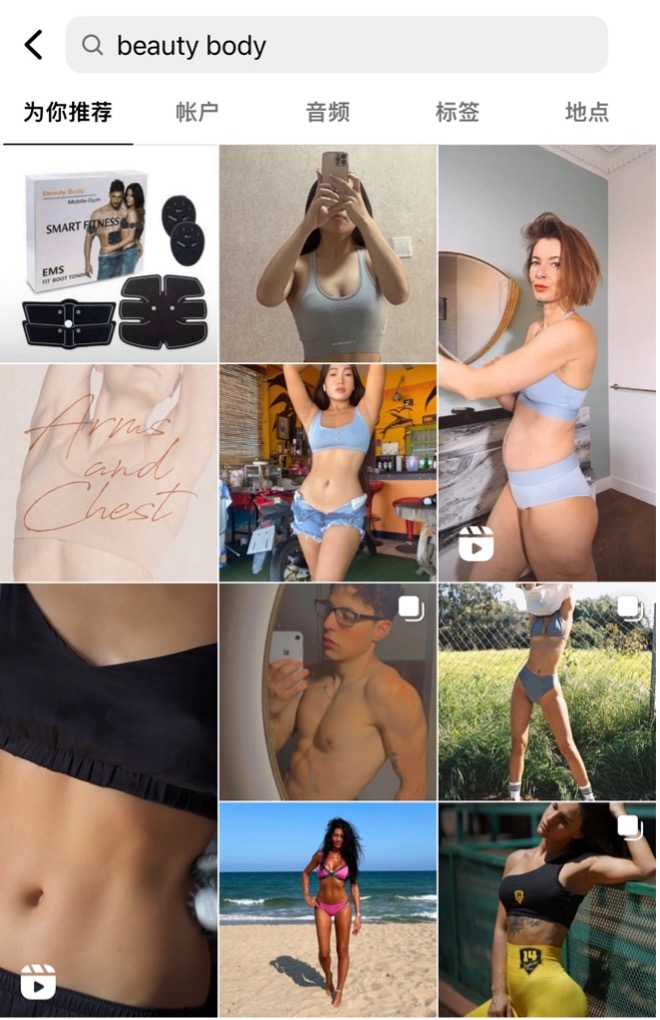
Similarly, when searching for another keyword “pretty body”, the results are even more pronounced. Almost all of the top ten photos and videos are images of young women, with a significant proportion being Caucasian, and many portrayed fit physiques. The results of these image searches, as well as the large amount of content on ins, can deepen young women’s body anxiety, and even lead to deeper stereotypes of young women’s body images. In reality, women come in all shapes and sizes and skin colours, and no particular body shape can be defined as uniquely beautiful.
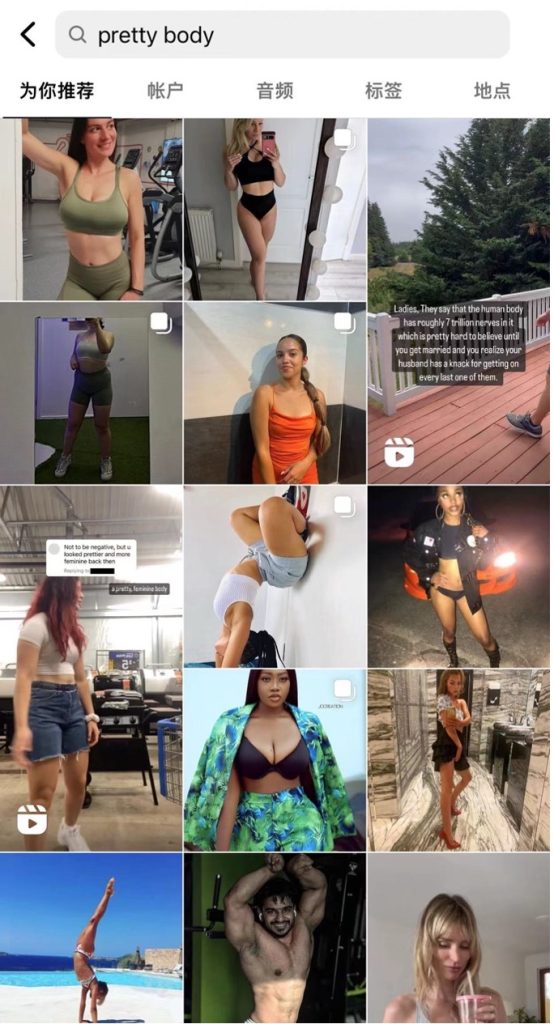
And this body image stereotype is not limited to women but also includes men. Men are also faced with the body image stereotype which may result in body dissatisfaction. Shows that the male body with high levels of muscularity and leanness is mostly depicted on Instagram and this kind of post gets more responses.(Gültzow, T & Hoving, C. (2020). I also searched for the keyword “men’s body”, and most of the results feature powerful and tense muscles on men’s bodies, which is a stereotype about male body image.
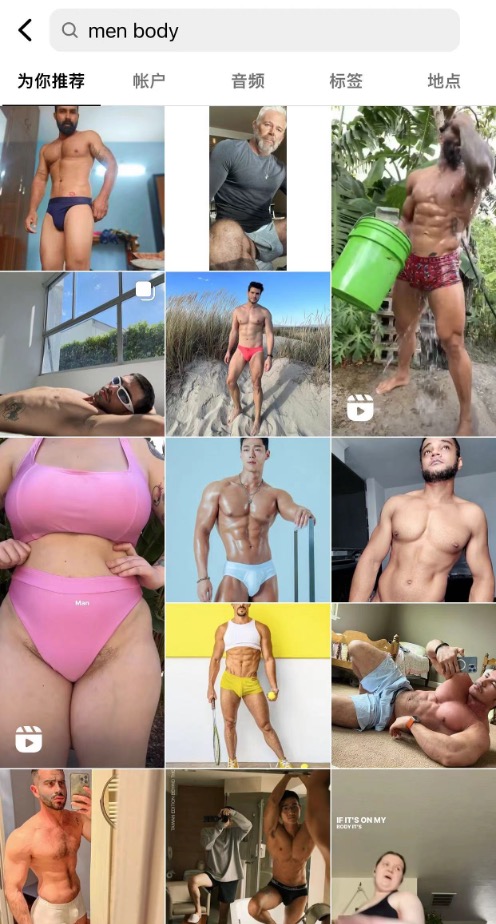
Factors that contribute to body image stereotypes
The reinforcement and deepening of body image stereotypes on Instagram are influenced by various factors.
Firstly, the platform exhibits a form of celebrity effect where young female followers are prone to pursuing trends and fashion. They tend to emulate the body image and behaviours of celebrities and micro-celebrities (Gültzow, T. & Hoving, C. 2020). Celebrities often cultivate an image of beauty, wealth, and success on Instagram, and this includes promoting certain body stereotypes. Some celebrities who frequently showcase their bodies on the platform may promote slim, toned, and physically fit body types as desirable.
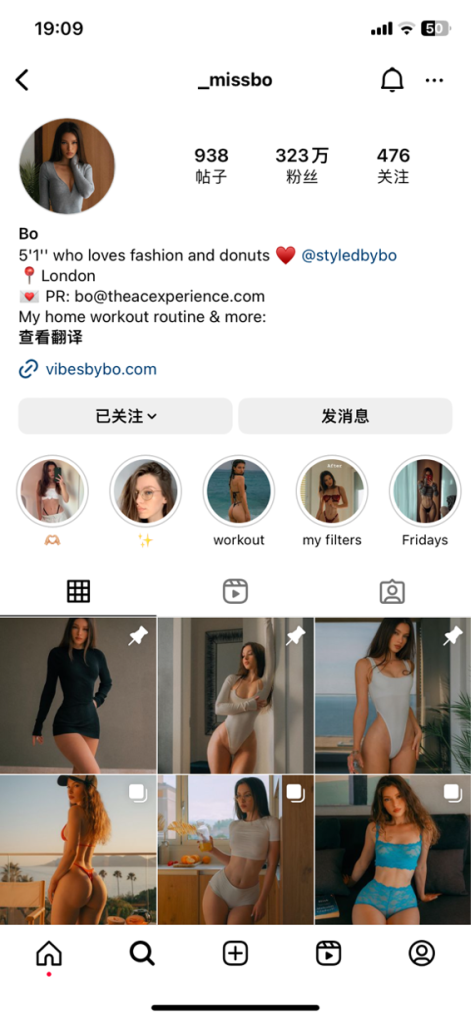
https://instagram.com/_missbo?igshid=MWZjMTM2ODFkZg==
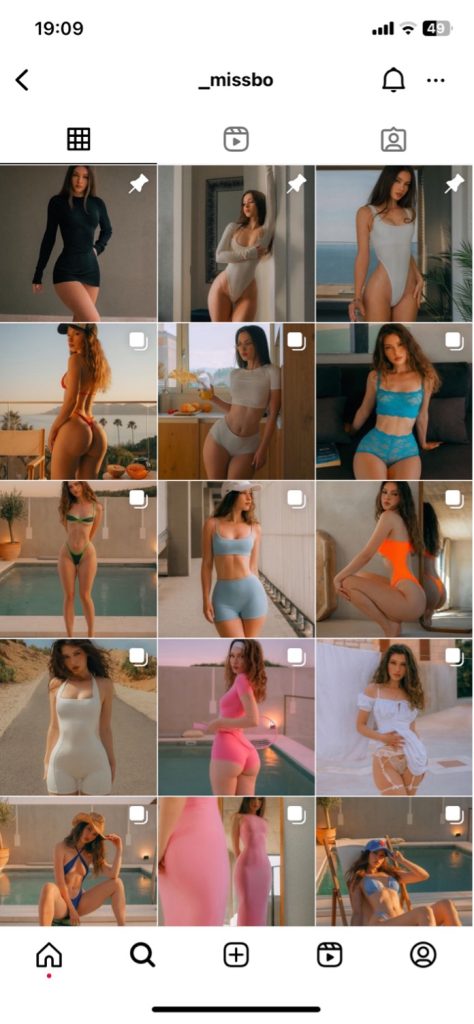
https://instagram.com/_missbo?igshid=MWZjMTM2ODFkZg==
Secondly, micro-celebrities play a significant role in shaping people’s perceptions of body image. Instagram, as a self-media platform, can empower every user to become a content producer, blurring the line between consumers and creators. During this process, micro-celebrities occur on Instagram, who engage in self-branding and craft specific personas that often revolve around certain body stereotypes (Khamis, S. & Welling, R.2016). These stereotypes are closely tied to aesthetic norms and are frequently accompanied by tags like “pretty girl.” As a result, micro-celebrities partly contribute to the reinforcement and solidification of prevailing beauty standards, influencing the collective perception of beauty on the platform.
In addition, some functions on Instagram also contribute to the reinforcement and deepening of body image stereotypes.
The concern surrounding Instagram’s algorithmic recommendations is related to the bias in the search results of specific keywords. For example, as demonstrated in the previous “pretty body” keyword search, search results often represent the certain body types showing leanness and muscles. And Instagram’s primary emphasis on content centered around appearance, primarily in visual formats like videos and images, can solidify particular perceptions, especially those related to body image.
Another issue within the platform revolves around data gathering. Quantifiable metrics such as comments and likes incentivize users to pursue current fashion trends and trending content. Celebrities and micro-celebrities might exploit this way by sharing images about stereotypical body standards in order to get more likes or comments to increase their visibility, further perpetuating these stereotypes. Consequently, this can result in more critical assessments of young women’s body image, as evidenced by the comments made by fans on celebrity body photos.
Moreover, the growing prevalence of trends like selfies and filters on Instagram, which offer enhancements for beauty, slimming effects, and options for lighter skin tones on Instagram, deepens the stereotypes associated with excessively lean, slim, and fair complexions( Ridgway, J. L., & Clayton, R. B. 2016).
The significance of realizing body image stereotypes on Instagram
Social media platforms have the capacity to welcome users from a wide range of skin tones and diverse ethnic backgrounds, with the goal of enriching the platform’s content and fostering diversity and inclusivity. However, despite the diverse user base, content on these platforms remains subject to algorithmic constraints, and mainstream content often retains inherent biases including beauty stereotypes. While social media platforms may aim to promote diversity and inclusiveness, the practical truth lies in the limitations of algorithms, resulting in certain types of content gaining prominence in users’ feeds and perpetuating existing stereotypes.
Actually, body image is diverse and any healthy body should be treated equally and not be subjected to casual criticism or blame.
First of all, the public should be aware of the existence of such a problem, and then the platforms should also make some changes, and try to be as diversified as possible when recommending some content, and reflect diversified values and aesthetics when presenting search results about body images.
Moreover, the phenomenon is underpinned by some deep-rooted social psychological problems, such as convergence, excessive pursuit of beauty, as well as competitive psychology including intrasexual competition and appearance-related comparisons. (Hendrickse,J& Ridgway, J. L. 2017).
After realizing the body image stereotype on Instagram, people can avoid the assimilation of their own aesthetics, keep a good mind not chasing after homogenised beauty, and be alert to the potential dangers or risks brought by the digital age.
Overall, within the realm of social media, this paper has explored how Instagram reinforces body image stereotypes and rigid beauty standards which spark concerns among young women about their body image. We have conducted an in-depth examination of several influencing factors, including platform algorithms, celebrity influences, user interactions, and the beauty-enhancing filters offered by the platform itself. These elements jointly contribute to the proliferation of certain stereotypes. Indeed, it is imperative to underscore that body image should embrace diversity and inclusivity, affording equal respect to all healthy body types. In the era of social media, platforms should shoulder the responsibility of advocating for diversity and body positivity to foster more favorable, healthy, and inclusive perceptions of body image (Sophie L. Nelson, 2017). As users, we can persistently work towards ameliorating the impact of social media on body image, empowering young women with enhanced confidence and self-esteem, and collaboratively cultivating a more positive social media environment.
Reference:
Cohen, R., Newton-John, T., & Slater, A. (2017). The relationship between Facebook and Instagram appearance-focused activities and body image concerns in young women. Body Image, 23, 183–187. https://doi.org/10.1016/j.bodyim.2017.10.002
Smerth Instagram statistics for 2023. (2023, September 10). Social Media Perth #SMPerth. https://www.sciencedirect.com/science/article/abs/pii/S1740144517302450
Gültzow, T., Guidry, J. P. D., Schneider, F., & Hoving, C. (2020). Male Body Image Portrayals on Instagram. Cyberpsychology, Behavior and Social Networking, 23(5), 281–289. https://doi.org/10.1089/cyber.2019.0368
Hendrickse, J., Arpan, L. M., Clayton, R. B., & Ridgway, J. L. (2017). Instagram and college women’s body image: Investigating the roles of appearance-related comparisons and intrasexual competition. Computers in Human Behavior, 74, 92-100. https://doi.org/10.1016/j.chb.2017.04.027
Khamis, S., Ang, L., & Welling, R. (2016). Self-branding, ‘micro-celebrity’ and the rise of social media influencers. Celebrity Studies, 8(2), 191-208. https://doi.org/10.1080/19392397.2016.1218292
Ridgway, J. L., & Clayton, R. B. (2016). Instagram Unfiltered: Exploring Associations of Body Image Satisfaction, Instagram #Selfie Posting, and Negative Romantic Relationship Outcomes. Cyberpsychology, Behavior and Social Networking, 19(1), 2–7. https://doi.org/10.1089/cyber.2015.0433
Sophie L. Nelson Computers in Human Behavior Issues 74 Research Articles in July 2017 Edition. (2017). In Targeted News Service. Targeted News Service.


